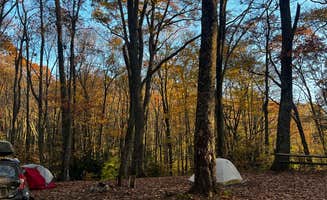Dispersed camping near Big Stone Gap, Virginia ranges across wildlife management areas with varying terrain and accessibility challenges. Hidden Valley WMA sits at approximately 2,000 feet elevation surrounded by the Appalachian Mountains, creating cooler temperatures compared to surrounding lowland areas. Camping authorization requires purchase of a Virginia Wildlife Access Pass with camping authorization added to the account for legal stays.
What to do
Water recreation options: The lake at Hidden Valley WMA provides calm water suitable for kayaking, canoeing and fishing. One visitor noted the "Lake is calm and clean for water recreation," making it ideal for paddlers seeking peaceful water experiences.
Hiking through fern forests: The surrounding woodland features distinctive fern-filled terrain that creates unique hiking opportunities. A camper described the area as a "pretty quiet cool fern filled Forrest and lake," highlighting the distinctive understory vegetation that differs from typical Appalachian forest environments.
Wildlife observation: The management areas support diverse wildlife populations requiring appropriate food storage. Campers should utilize the provided "bear bins" mentioned by reviewers to prevent unwanted animal encounters during overnight stays.
What campers like
Solitude and privacy: Many visitors appreciate the secluded nature of rustic camping sites near Big Stone Gap. According to one review, "We had the place to ourselves which was really great," indicating low visitation levels even during peak seasons.
Basic amenities: Hidden Valley WMA offers more facilities than typical dispersed camping areas. A camper noted, "Porta Jon available at campground and boat dock. Plenty of dead wood for fires. Trash cans available," which provides basic conveniences while maintaining a primitive camping experience.
Affordability: Camping authorization through Virginia Wildlife permits keeps costs minimal. One visitor explained the process: "Camping is free, technically. (you need to purchase an Access pass from Virginia Wildlife for 4 dollars online, and add a camping authorisation to your account)."
What you should know
Road conditions: Access roads to camping areas feature steep grades requiring capable vehicles. A visitor to Asher Hunting Access Area warned, "The road up is a pretty harsh grade for 4 miles. Our short bus Skoolie had some troubles with it," highlighting potential challenges for larger vehicles or those with limited clearance.
Campsite layout: The camping areas offer limited established sites rather than extensive dispersed options. One camper described, "The camp area is alright - 4 ish areas to pull up to and a few tent sites."
Occasional night traffic: While generally quiet, some camping areas experience periodic vehicle traffic after dark. A reviewer mentioned, "There also are a few peculiar (methy) characters that come in and out of the parking lot at night," suggesting campers should select sites away from parking areas when possible.
Tips for camping with families
Fire rings and sites: When camping with children, utilize the established fire areas for safety. A visitor noted, "Rocks for fire pits and no tables," so families should bring portable tables or other flat surfaces for meal preparation and dining.
Weather preparedness: The elevated terrain around Big Stone Gap experiences temperature fluctuations and increased precipitation compared to surrounding areas. Pack layers and rain gear regardless of forecast, especially when visiting Paul Van Booven Wildlife Management Area and other higher-elevation sites.
Distance from facilities: Plan accordingly for limited facilities at most dispersed sites. While some areas have "Porta Jon available at campground and boat dock," many locations lack restroom facilities entirely, requiring appropriate preparation for families.
Tips from RVers
Site limitations: RV camping options near Big Stone Gap are restricted by space and access. A visitor mentioned the limited layout with "4 ish areas to pull up to," indicating few suitable spaces for larger vehicles.
Grade challenges: The mountainous terrain creates difficult driving conditions for recreational vehicles. One RVer warned about "a pretty harsh grade for 4 miles" that caused difficulties even for their "short bus Skoolie," suggesting larger motorhomes and trailers may struggle with access.
Leveling requirements: Bring substantial leveling equipment as the natural terrain at dispersed sites lacks grading. Most sites have "Rocks for fire pits and no tables," indicating minimal site preparation and potentially uneven ground for parking and stabilizing RVs.


